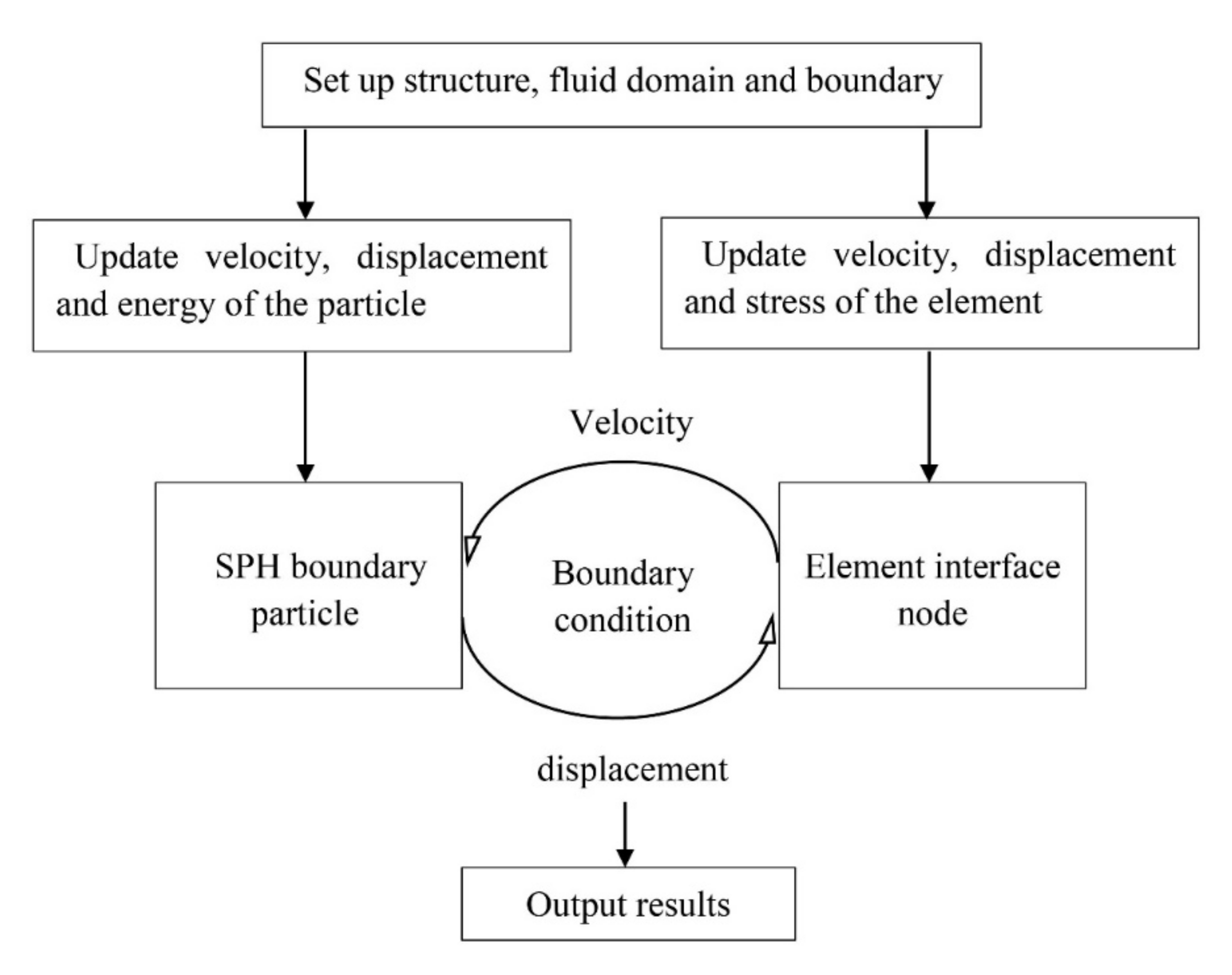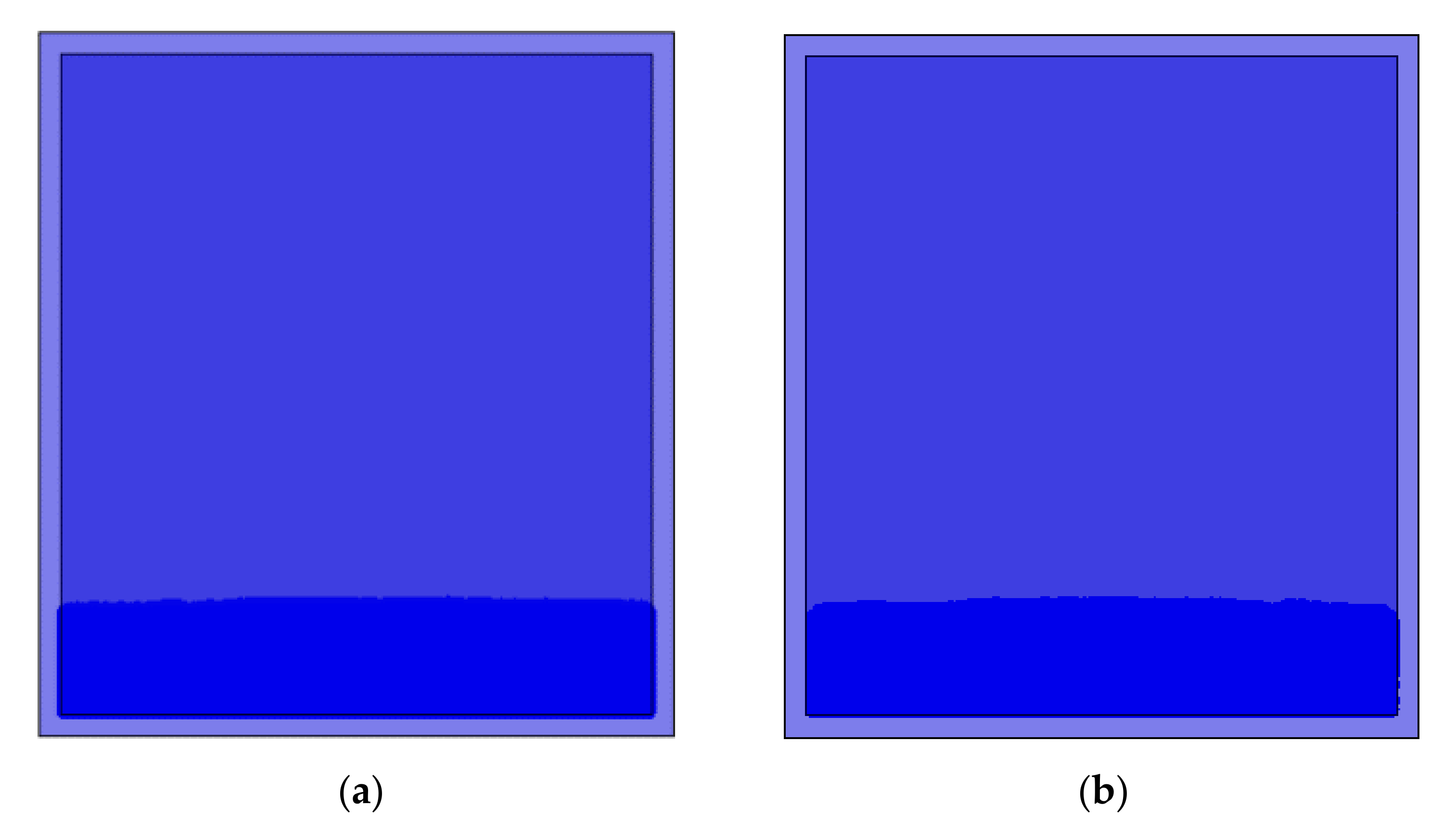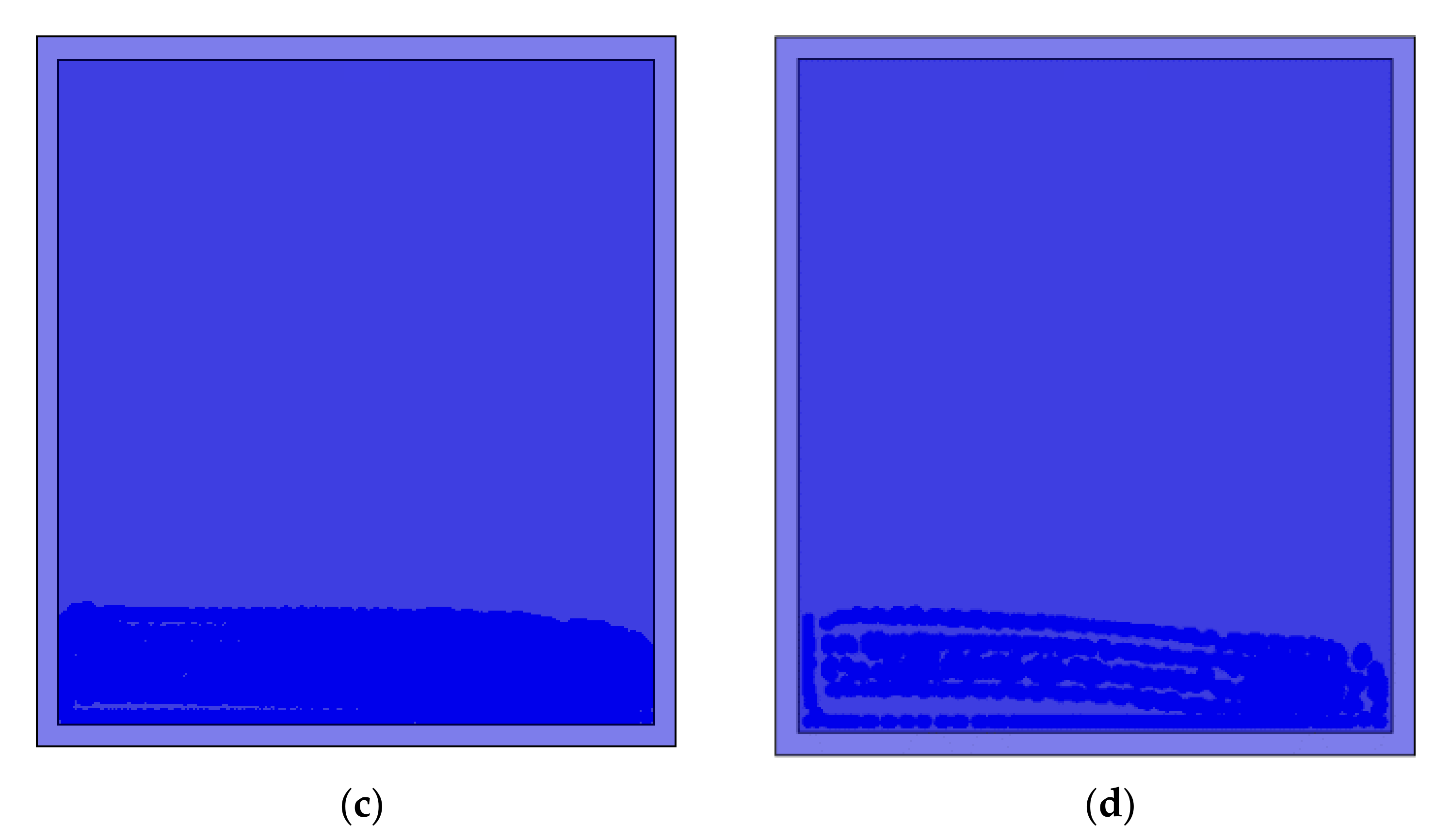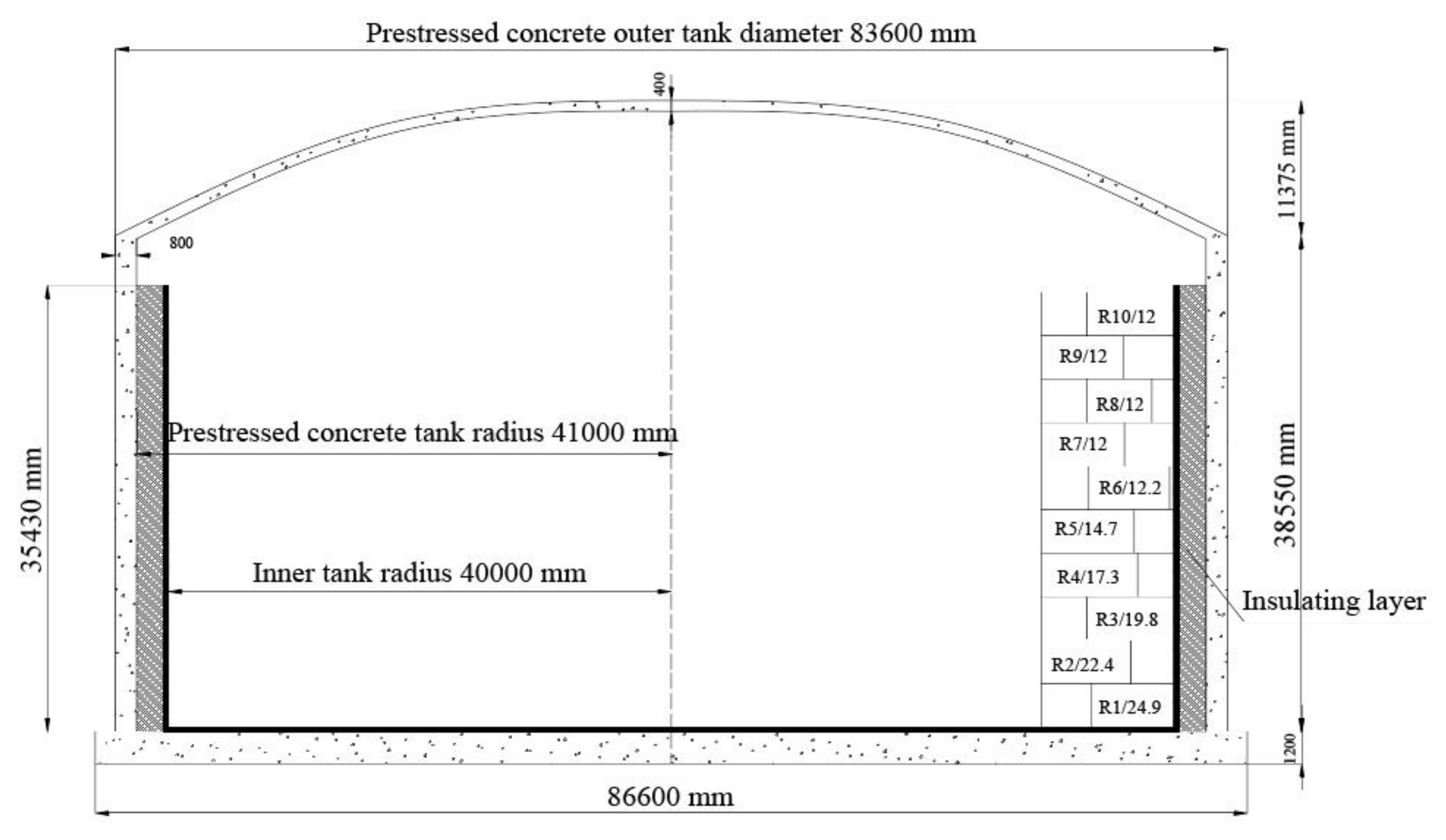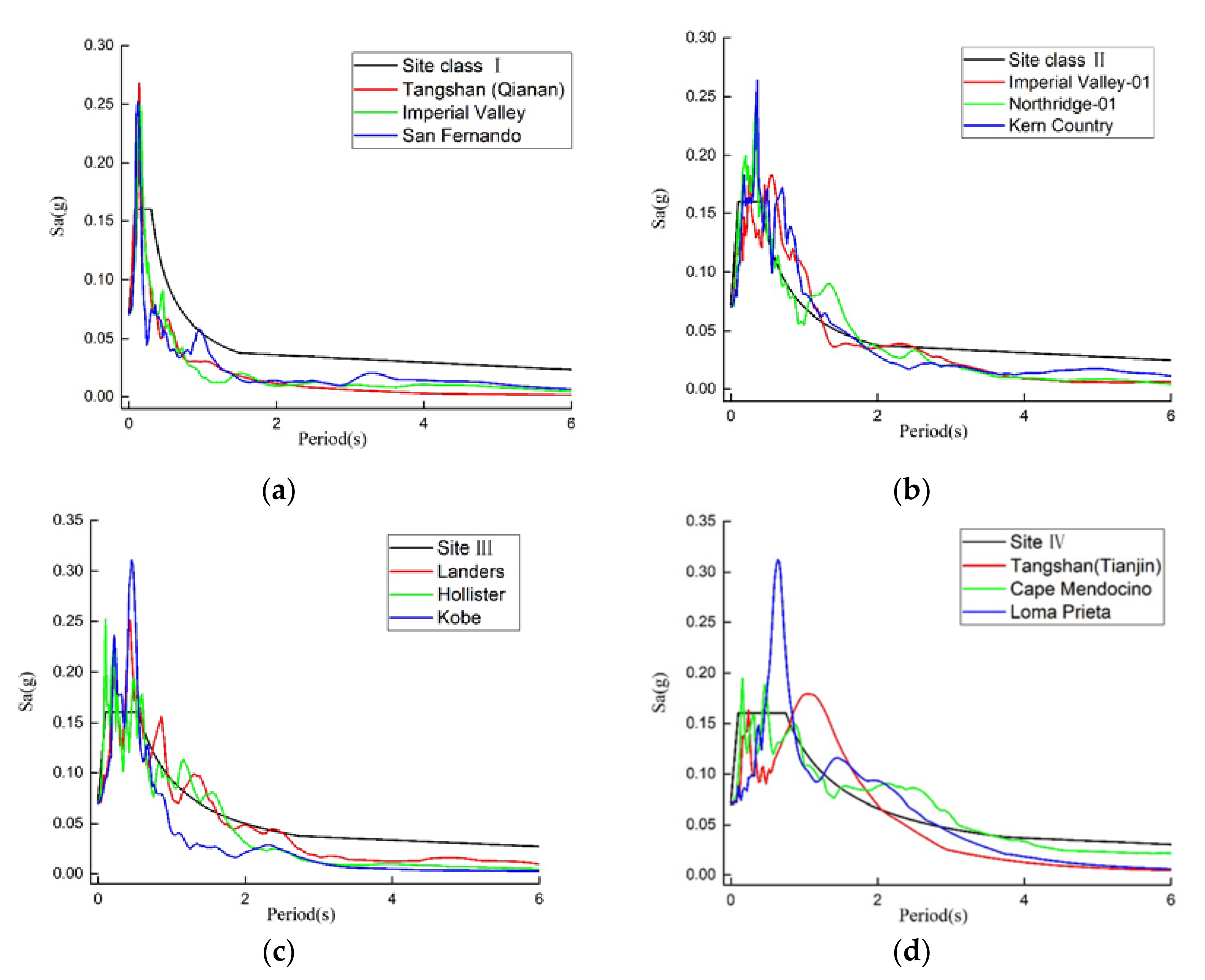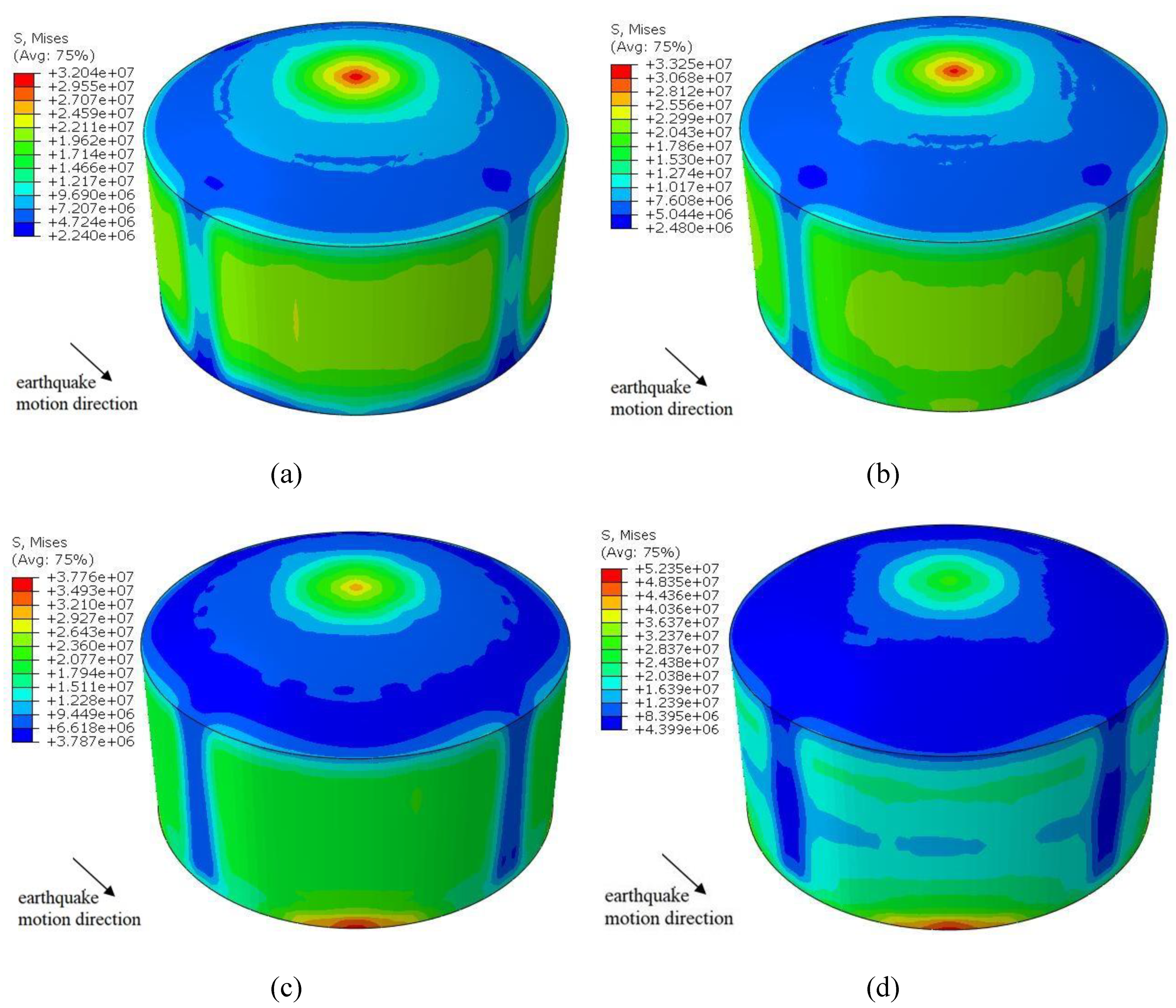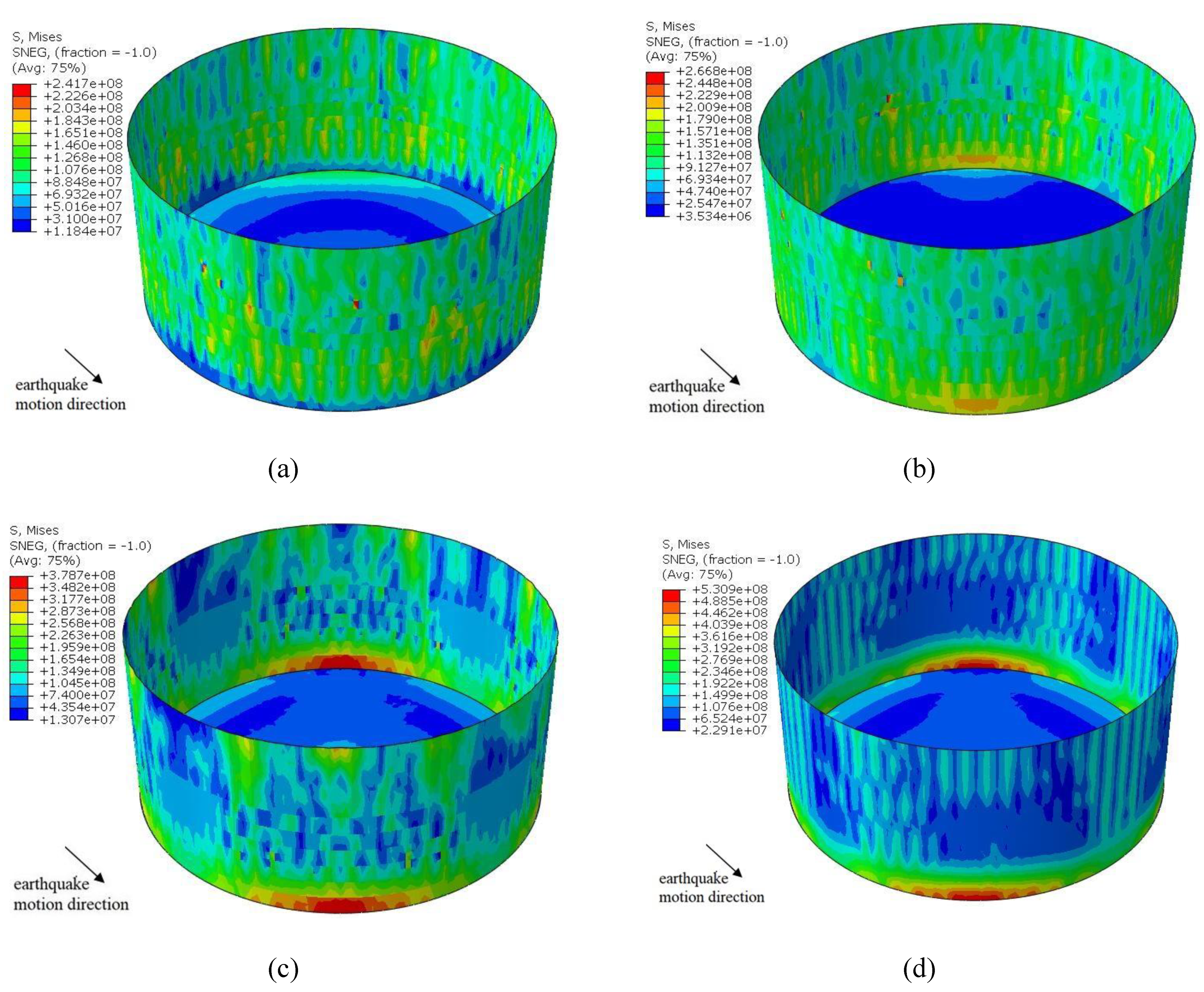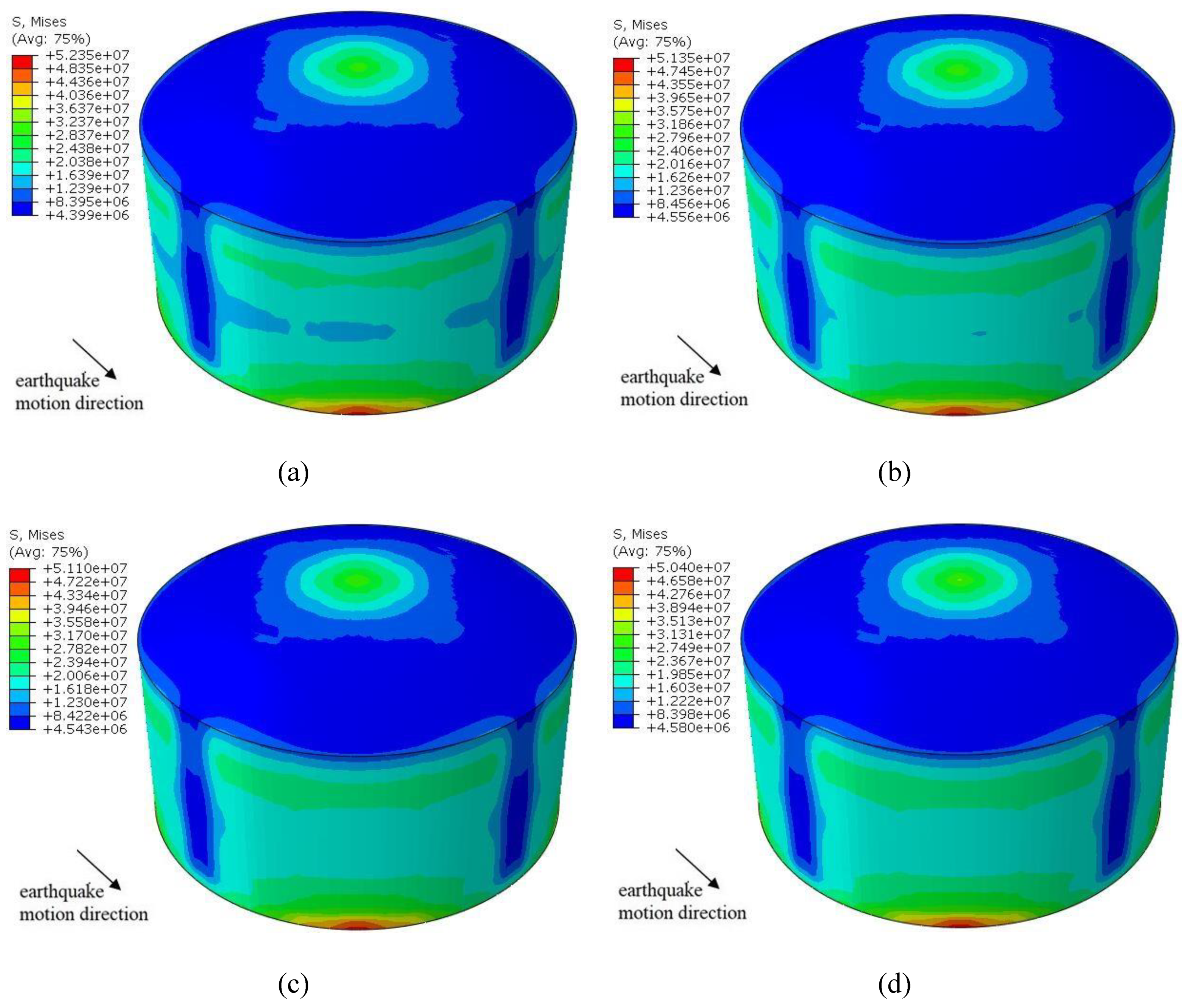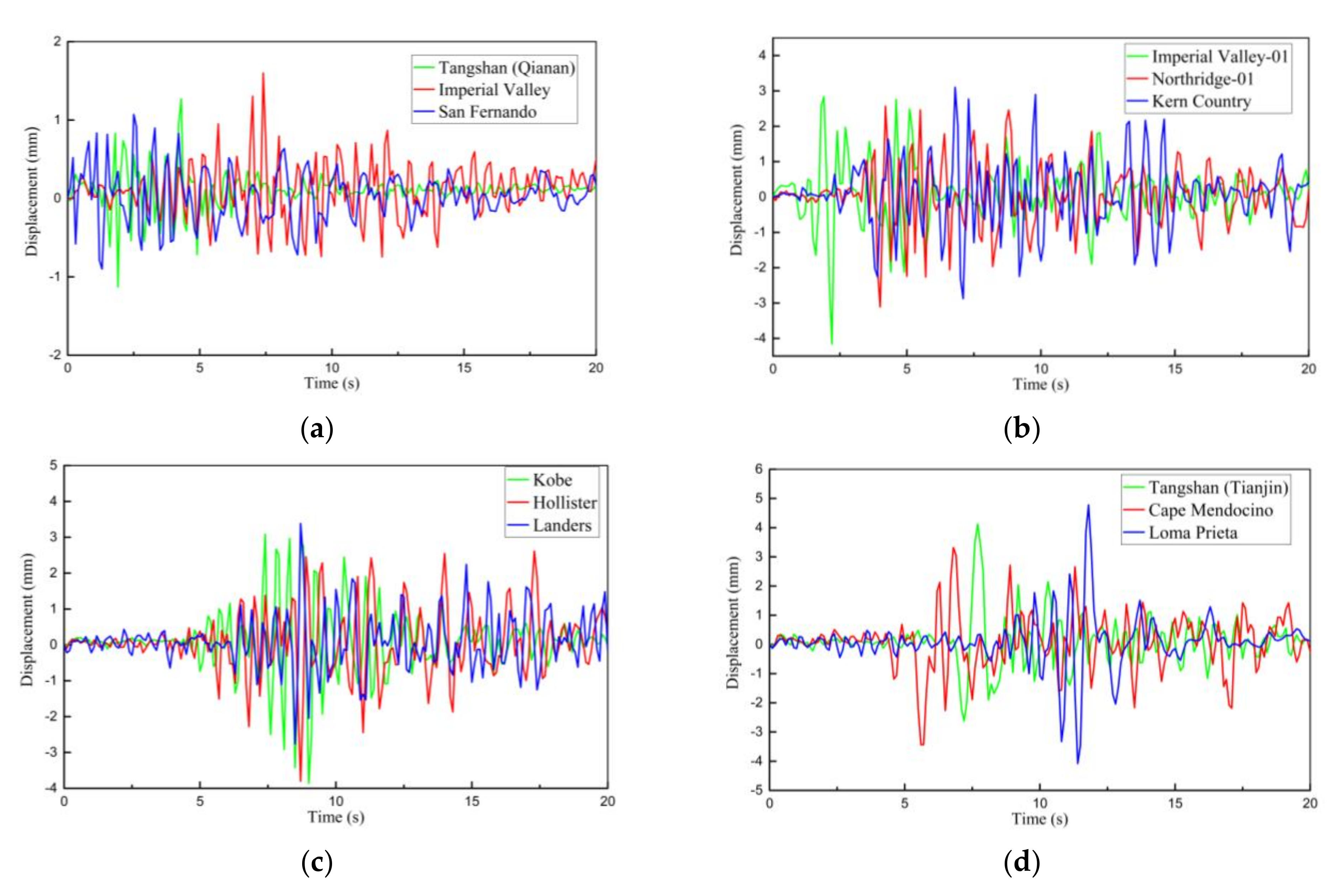4.2. Finite Element Model
This study uses the ABAQUS software [
33,
34] to establish a finite element model (FEM) as shown in
Figure 5. Because the tank model is extremely large, the associated interactions are very complex. The ‘Embedded’ option in ABAQUS is used to embed rebar rods within the tank wall, which enables the rebar elements to work in relation to each other. The outer tank and the insulation layer are represented by C3D8R mesh elements [
33,
34]. The inner tank is represented by S4R shell elements [
33,
34] because its thickness is much lower than its radius of curvature. The aforementioned
equation in
Section 3 is used to discretize the LNG liquid into particles. The element size is chosen according to the small tank in
Section 3 that produces an accurate sloshing frequency calculation. The ratio of liquid element size to container size of the large tank is identical to that of the small tank in
Section 3.
The protective cover encompasses 19T15S steel cables with a tensile strength of 1860 MPa. The top and bottom of the concrete wall consist of 122 vertically anchored steel cables. 220 circumferential steel cables are anchored in semicircles on four vertical supporting columns at 90° [
35].
Prestress in ABAQUS can be applied using different approaches, such as the initial stress method, the model predictive control (MPC) method, the single rebar element method, and the falling temperature method. The falling temperature method is used in this study to apply prestress by decreasing temperature. The initial temperature of the prestressed rebar is calculated with the following Equation:
where
N is the tensile force in the prestressed rebar, which shall be no more than 75% of the prestressed rebar’s standard strength;
λ is the thermal expansion coefficient;
E is the elastic modulus;
A is the cross-sectional area.
The bottom boundary of the model is fixed without considering any interaction between soil and structure. The static condition of the LNG tank is obtained based on its own weight to make sure that the LNG liquid reaches steady state.
4.3. Modal Analysis
Natural frequencies, such as the liquid-solid coupling frequency and the liquid sloshing frequency, are essential parameters in the design and analysis of LNG prestressed storage tanks. To determine the natural frequency, three methods are primarily used for extracting eigenvalues in ABAQUS: the subspace iteration method, the AMS eigensolver, and the block Lanczos algorithm. This study uses the Lanczos algorithm to calculate the first frequency of the empty tank as 3.753 Hz. According to specifications [
36], the basic natural frequency of solid–liquid coupling is shown as:
where
R is the radius of the inner tank;
ρ is the density of the LNG liquid;
E is elastic modulus of the inner tank;
δ is the thickness of the inner tank at 1/3 of the total height;
H is the height from the tank bottom to the liquid level.
In addition, according to specifications [
36], the basic natural vibration period of liquid sloshing is shown in the following Equation:
where D is inner tank diameter;
T is the basic period; cth is the hyperbolic tangent function; g is the acceleration of gravity. The basic natural frequency of solid-liquid coupling and the basic natural frequency of liquid sloshing under different liquid levels are listed in
Table 7 and
Table 8.
As shown in
Table 7 and
Table 8, the simulation results of natural frequency of solid-liquid coupling and the basic natural frequency of liquid sloshing in large LNG storage tanks are in agreement with relevant theoretical results. More specifically, both simulation and theoretical results show that the basic natural frequency of solid-liquid coupling decreases with increasing liquid level, while the basic natural frequency of liquid sloshing increases with increasing liquid level. Therefore, the accuracy and feasibility of using numerical simulation for LNG tanks is demonstrated.
4.5. Results
The simulation of a large LNG tank using the SPH-FEM algorithm is entirely performed on an ordinary personal computer. The computer has an Intel(R) Core(TM) i7-8700 CPU @ 4.10 GHz processor and an installation memory of 16.00 GB.
Out of the 12 seismic waves in four site classes, the San Fernando seismic wave produces the largest stress on the outer and inner tank under different liquid volume. Therefore, in
Figure 7 and
Figure 8, the San Fernando wave is selected to compare the maximum stress experienced by the outer and inner tank at different liquid volumes. In addition, to compare the maximum stress at different site conditions in
Figure 9 and
Figure 10, each site is represented by one of the three seismic waves that produces the greatest stress on the outer and inner tank. Therefore, Taft, Hollister, and Loma Prieta are selected for Class II, Class III, and Class IV, respectively. Furthermore, when comparing the four different site conditions, each model is filled with 100% LNG, which produces the greatest von Mises stress on the outer and inner tank compared to other liquid volumes.
In general, stress distribution on the outer tank exhibits a symmetrical trend about the X- and
Z-axis.
Figure 7 shows the respective maximum stress of the outer tank with LNG levels of 25%, 50%, 75% and 100%. Under the same liquid level, the level of stress on the outer tank is the largest in Class I, followed by Class II, Class III and Class IV, though their values are relatively similar. In addition, under the same site class, the stress distribution on the outer tank is minimally affected by different liquid levels. On the other hand, the location of maximum stress on the outer tank changes depending on liquid level. With LNG liquid levels of 25% and 50%, the maximum stress of the outer tank is located at the dome; however, with LNG liquid levels of 75% and 100%, the maximum stress of the outer tank is at the bottom of the tank. This phenomenon occurs because gravity plays a more important role than pressure with LNG liquid levels of 25% and 50%, and pressure at the bottom increases at a much faster rate relative to the dome as liquid level rises. Furthermore, the maximum stress of the outer tank is nearly identical at the liquid level of 25%, 50%, and 75%, but the maximum stress of the outer tank increases significantly from 75% liquid level to 100% liquid level. As a result, more extensive design and analysis considerations should be paid to the dome and bottom of large LNG tanks depending on the liquid level. The more vulnerable sections of the tank may need to be specifically strengthened.
When the tank is filled with 100% LNG, the maximum stress of the inner tank is above 500 MPa in all four site classes, which jeopardizes the safety of the structure considering the fact that the yield strength of 9% steel is between 500 MPa and 600 MPa [
38]. Because the consequences of large LNG tank failure are severe, it is imperative to reduce the stress on the inner tank to ensure their safety. At the same time, an early warning system should be implemented to control the maximum liquid level. Different from the outer tank, the stress of the inner tank changes significantly with the liquid level. When the liquid level is at 25% and 50%, the maximum stress of the inner tank is below 300 MPa. At a liquid level of 75% and 100%, maximum stress exceeds 300 MPa and 500 MPa, respectively. With an increase in the amount of LNG, the stress at the base of the inner tank gradually increases to notable levels. Therefore, the bottom of the tank warrants close attention during design and construction.
The structural behaviour of the inner tank at different location types is also individually analyzed. Under the same liquid level, the inner tank behaves similarly to the outer tank with the stress in Class I being the largest, Class II being second largest, and Class III and IV being the smallest. Under 100% liquid level, the stress of the inner tank differs significantly under different site classes. Therefore, considering their behaviour at different location types, close attention should be paid to the design of LNG tanks under high liquid levels.
The rationale for selecting applicable conditions for displacement analysis of the outer tank is similar to the aforementioned rationale for stress analysis. To compare the effect of site conditions on the tip displacement of the outer tank, each case is modelled with 100% LNG as the most critical liquid level in
Figure 11. In addition, to compare the tip displacement of the outer tank for different liquid volume, Class IV is selected for having the largest tip displacement, as shown in
Table 10. The maximum tip displacements of the outer tank at different liquid volume and different site conditions are summarized in
Table 10. A more concise summary is shown in
Table 11 by averaging the maximum displacements produced by seismic waves within the same site condition. In most cases, under the same liquid height, Class IV experiences the largest displacement, followed by Class III, Class II, and Class I. This phenomenon indicates that less ideal site conditions correspond to greater tip displacements of an LNG storage tank. In addition, this phenomenon is consistent with the Chinese seismic code [
37], which states that site differences directly affect the seismic design of the structure. An exception to this phenomenon is the El Centro seismic wave of site Class II with a displacement similar to the waves in site Class IV. Because the characteristic period of the El Centro wave is closer to the natural vibration period of the structure, the vibration of structures under the El Centro wave is more sensitive to increasing liquid levels. Other exceptions include Kobe and Landers waves under site Class III, where displacement decreases with the increase in liquid volume. More specifically, tip displacement of the outer wall is greater at 25% liquid level than at 50% liquid level. This phenomenon may be a result of the complicated relationship between frequency of solid–liquid coupling, sloshing frequency, and the characteristic period of seismic waves. The basic natural frequency of solid-liquid coupling decreases with the increase in liquid storage, while the basic natural frequency of liquid sloshing increases with the increase in liquid storage as mentioned in
Section 4.3. As a result, the actual tip displacement is less predictable depending on the amount of influence from different contributing factors.
Under the same site class, the displacements produced by the three seismic waves are on a similar level. For the same seismic wave, general trends in the displacement graphs are nearly identical for different liquid volume, and the displacement increases with the increase in liquid volume. The maximum displacement in all four site classes reaches 4.78 mm when the tank is filled with 100% LNG under Loma Prieta wave; the minimum displacement is only 0.64 mm when the tank is filled with 25% LNG under Tangshan Aftershock (Qianan) wave. These values again demonstrate that the displacement response of an LNG storage tank varies according to different site classes and different liquid volume. In Class I and Class II, the displacement is nearly identical at the liquid level of 25% and 50%. However, from 50% liquid level to 75% liquid level, the displacement increases significantly. On the other hand, the tip displacements of the LNG tank at liquid level of 25% and 50% under site Class IV are nearly identical to the displacements at liquid level of 75% and 100% under site Class II. In summary, both liquid volume and site condition are important influencing factors in the dynamic analysis and structural design of LNG tanks.
When comparing the base shear of the tank at different liquid depths as shown in
Figure 12 and
Figure 13, both Class III and Class IV are selected to represent the most critical soil types. More specifically, Class III produces the greatest base shear under 75% and 100% liquid levels, followed by site Class IV, site Class II, and site Class I. Class IV produces the greatest base shear under 25% and 50% liquid levels, followed by site Class III, site Class II, and site Class I. When comparing the effect of site conditions on the base shear of the tank, each model is again modelled with 100% LNG as the most critical liquid level in
Table 12. The maximum base shear values of the tank at different liquid volume and different site conditions are listed in
Table 12 and
Table 13 and further summarize the results by averaging the maximum values from the same site condition. The base shear produced by site Class III increases significantly from a liquid level of 25% to 100%. Again, as illustrated in the Chinese building code, site differences directly affect seismic design parameters of a structure including base shear. Generally, base shear increases with the increase in liquid volume with the exception of Tangshan Aftershock and San Fernando seismic waves of site Class I, as well as Tangshan Aftershock and Cape Mendocino seismic waves of site Class IV. For these waves, the base shear of the 50% liquid level is larger than that of 75% liquid level.
Under the same site class, base shear values of the three seismic waves are roughly in the same range. For the same seismic wave, general trends in the base shear graphs are nearly identical for different liquid volume. The variation of peak forces with different liquid volume are also very similar. The maximum base shear in all four site classes reaches 11.16 × 104 KN when the tank is filled with 100% LNG under the Landers wave; the minimum base shear is only 2.75 × 104 KN when the tank is filled with 25% LNG liquid volume under Tangshan Aftershock (Qianan) wave. In addition, the base shear of site Class II only varies slightly for a liquid level of 25% and 50%, but it varies significantly for a liquid level of 75% and 100%. These disparities demonstrate that the base shear of a LNG storage tank is strongly dependent on the corresponding site classes and the liquid level in the tank.
